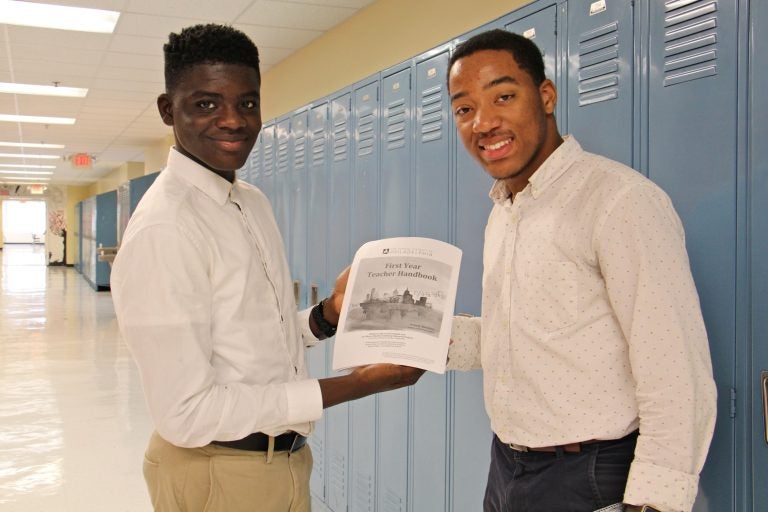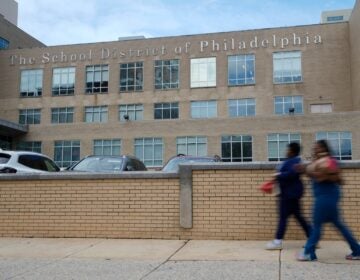With glossary of city slang, Philly students create jawn for new teachers
The handbook contains sections with student perspectives on classroom situations, reminiscences of inspiring teachers, and a listing of the latest slang.

Science Leadership Academy students Khalid Abogourin (left), 17, and Horace Ryans III, 16, created a handbook for first-year teachers that is being used in teacher orientations throughout the Philadelphia School District. (Emma Lee/WHYY)
As Philadelphia students get ready to return to school next week, some teachers got a little homework in the form of a handbook that includes a glossary of Philly slang.
Students created the guides for first-year teachers in Philadelphia’s School District to help acquaint them with unfamiliar territory.
The handbook includes sections on how to engage students; offers insights on recognizing good behavior and resolving problems; and features student reflections on inspiring teachers.
Compilers Horace Ryans III and Khalid Abogourin, who were inspired by a teacher handbook from Omaha, Nebraska, believed they could do better.
“We can make this Philly. We can make it make it ours. And so that’s what we decided to do,” said Ryans, a rising junior at Science Leadership Academy.
The pair interned in the School District of Philadelphia’s Office of Student Leadership and, along with Alfredo Praticò, put together the guide this summer.
Abogourin, who’s starting his senior year at Philadelphia Virtual Academy, said the three spent hours brainstorming as they developed the guide.
“We had to think — not only about what we want in schools or how we want educators to … teach us [and] make a equitable classroom — but how the 200,000 other students would want their classrooms,” he said.
Ryans says the goal was to help new teachers adjust.
“You need to be able to understand the culture and the environment and the language of those students if you’re going to go into an environment you are not used to,” the 16-year-old said. “We cannot have a teacher not understand what these kids are talking about and then expect them to teach them to the best of their ability.”
Abogourin, 17, said the glossary was one way for teachers and students to bridge the gap.
“You can’t really expect a teacher coming in from Ohio to come into a school and know every slang word,” he said. “But this would allow them to connect, share and grow with students.”
The glossary of 22 slang terms includes “drawlin,'” which means acting out; “bet,” a way to say yes; and of course, “jawn,” which can refer to any thing, person or place.
“These are words we heard the most … although some people might not agree,” Ryans said.
The Philadelphia-flavored lexicon had to fit on a single page, so they culled the list due to space.
First-year teacher Abigail Shagin, who will teach digital media and career skills to 10th- through 12th-graders at Science Leadership Academy, was one recipient of the guide.
“In between all the lessons and homework assignments and projects, there are human-to-human interactions,” she said. “So I think that this handbook was something that really was a fun and engaging way to hear the perspective of a high-schooler and kind of help you think about what you could do to build trust and relationships with your students.”
And the Mechanicsburg native now knows that “ocky” means fake.
John Kamal, who has taught engineering at Science Leadership Academy for four years, called the students’ work impressive.
“I was really impressed by what I saw,” he said of the new handbook. “I was really glad to see students take the time and their initiative to think about best ways for teachers to educate them and how teachers can build relationships with students … that makes learning easier for them.”
A Philadelphia native, Kamal attended public schools in Philadelphia decades ago.
“I had so much fun when I saw the glossary printed,” he said. “It really brought me back. I went to school in the ’60s and ’70s. And it brought me back to the idea that we had our own slang language that we used when I was growing up. And it was a whole heck of a lot of fun to see young kids today with their own version of it.”
The co-creators hope other students will update their guide every year.
They say the handbook was a way of giving young people a voice, and they’d like to send it out to other school districts as an example.
“It doesn’t even have to be created by students, but we just want to set forth an example so that they can make it better,” said Abogourin. “So that their education is not limited to things that happen in the classroom.”
WHYY is your source for fact-based, in-depth journalism and information. As a nonprofit organization, we rely on financial support from readers like you. Please give today.




